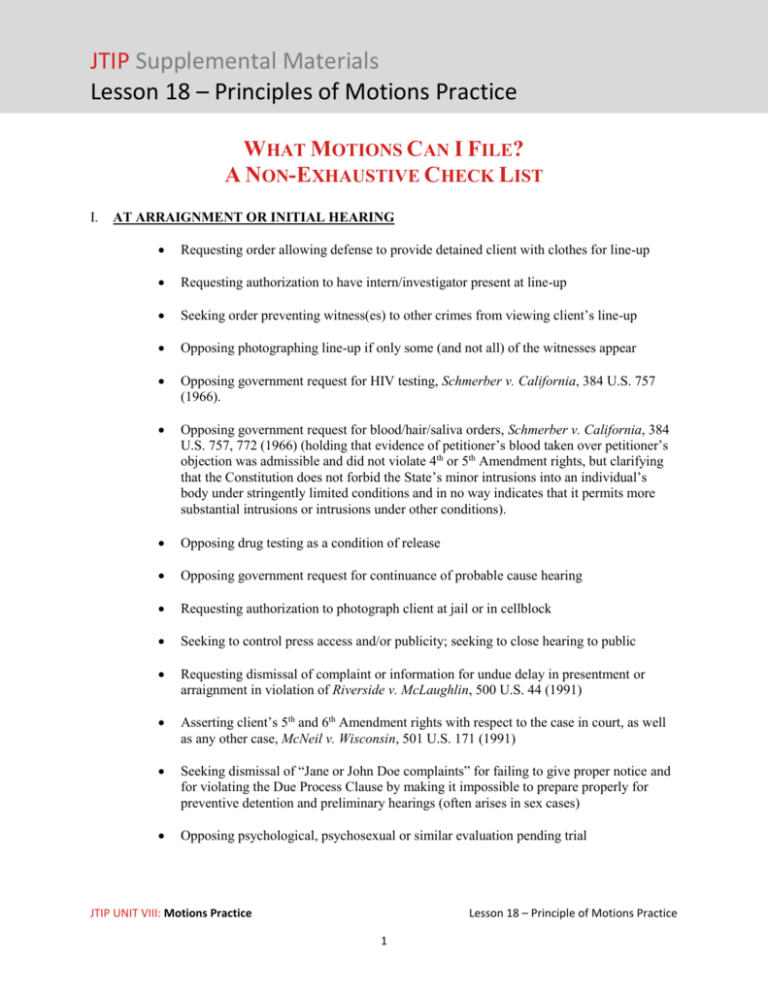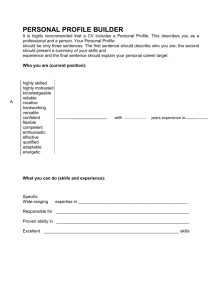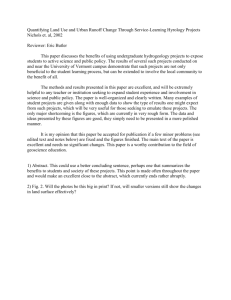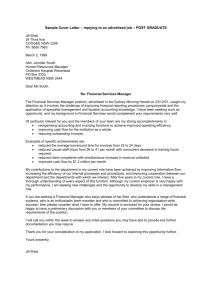What Motions Can I File? A Non
advertisement

JTIP Supplemental Materials Lesson 18 – Principles of Motions Practice WHAT MOTIONS CAN I FILE? A NON-EXHAUSTIVE CHECK LIST I. AT ARRAIGNMENT OR INITIAL HEARING Requesting order allowing defense to provide detained client with clothes for line-up Requesting authorization to have intern/investigator present at line-up Seeking order preventing witness(es) to other crimes from viewing client’s line-up Opposing photographing line-up if only some (and not all) of the witnesses appear Opposing government request for HIV testing, Schmerber v. California, 384 U.S. 757 (1966). Opposing government request for blood/hair/saliva orders, Schmerber v. California, 384 U.S. 757, 772 (1966) (holding that evidence of petitioner’s blood taken over petitioner’s objection was admissible and did not violate 4th or 5th Amendment rights, but clarifying that the Constitution does not forbid the State’s minor intrusions into an individual’s body under stringently limited conditions and in no way indicates that it permits more substantial intrusions or intrusions under other conditions). Opposing drug testing as a condition of release Opposing government request for continuance of probable cause hearing Requesting authorization to photograph client at jail or in cellblock Seeking to control press access and/or publicity; seeking to close hearing to public Requesting dismissal of complaint or information for undue delay in presentment or arraignment in violation of Riverside v. McLaughlin, 500 U.S. 44 (1991) Asserting client’s 5th and 6th Amendment rights with respect to the case in court, as well as any other case, McNeil v. Wisconsin, 501 U.S. 171 (1991) Seeking dismissal of “Jane or John Doe complaints” for failing to give proper notice and for violating the Due Process Clause by making it impossible to prepare properly for preventive detention and preliminary hearings (often arises in sex cases) Opposing psychological, psychosexual or similar evaluation pending trial JTIP UNIT VIII: Motions Practice Lesson 18 – Principle of Motions Practice 1 JTIP Supplemental Materials Lesson 18 – Principles of Motions Practice II. CHALLENGES TO THE CHARGING DOCUMENT Based on: Selective prosecution Vindictive prosecution Immunity/constitutional privilege Violation of statute of limitations Improper juvenile transfer to adult prosecution Insufficient allegations Vague allegations Unconstitutional statute, e.g. vagueness Invalid statute, e.g. improper use of emergency legislation, failure to update statute Duplicity (two charges in one count, raises unanimity problem) Multiplicity (one crime charged in several counts) Failure to allege the essential elements of the charged crime Failure to state proper jurisdiction of court in which charge is brought Abandonment of prosecution Unnecessary delay Pre-arrest delay Violation of speedy trial Loss or destruction of evidence (see Local Discovery Rule) Double jeopardy, prior conviction or acquittal for the same offense, or no manifest necessity for mistrial JTIP UNIT VIII: Motions Practice Lesson 18 – Principle of Motions Practice 2 JTIP Supplemental Materials Lesson 18 – Principles of Motions Practice Motion seeking: Bill of particulars o Can be particularly helpful in assault and destruction of property cases to pin down exactly what the alleged misconduct is. (Note: you may be able to obtain the same result by obtaining the information through informal discovery – see Local Discovery Rule – documenting that discovery in a discovery request letter and then putting it on the record as a preliminary matter that the trial is about the specified conduct. If the government tries to switch up or add additional conduct, you can claim a notice problem citing e.g., (Woodrow) Wilson v. United States, 606 A.2d 1017 (1992), for the right of the defense to rely on representations made by the government. III. SUPPRESSION OF EVIDENCE Statements: improper seizure (4th Amendment; no probable cause; no reasonable, articulable suspicion) Statements: pre-arraignment delay (Local Rule) Statements: Miranda (failure to give warning; involuntary waiver; improper re-initiation after assertion) Statements: voluntariness (5th Amendment) Statements: after right to counsel attaches Statements: illegal wiretap (Title III) Statements: violation of (extradition requirements; use in combination with 6th Amendment and local case) Statements: interviewing juveniles in detention (Local Rule) Tangible evidence: illegal search or seizure – 4th Amendment; think beyond probable cause and reasonable, articulable suspicion; was the manner of the search reasonable, e.g. Schmerber v. California, 384 U.S. 757 (1966) (holding that evidence of petitioner’s blood taken over petitioner’s objection was admissible and did not violate 4th or 5th Amendment rights, but clarifying that the Constitution does not forbid the State’s minor intrusions into an individual’s body under stringently limited conditions and in no way indicates that it permits more substantial intrusions or intrusions under other conditions) or excessive) Tangible evidence: fruit of other statutory or constitutional violation Tangible evidence: challenges to warrants JTIP UNIT VIII: Motions Practice Lesson 18 – Principle of Motions Practice 3 JTIP Supplemental Materials Lesson 18 – Principles of Motions Practice o o o o o o Knock and announce Franks violation Insufficient particularity Search exceeded scope of warrant Violation of statutory inventory/return requirements Staleness of affidavit Identification: improper seizure (4th Amendment) Identification: suggestivity (5th Amendment) Identification: right to counsel (line-up) Identification: unreliability (so unreliable that it is inadmissible as a matter of law; see, e.g., local cases) Due process challenges based on racial discrimination: Whren v. U.S., 517 U.S. 806 (1996) Seeking to treat defense motions as conceded V. INVESTIGATION Ex parte motions o Seeking judge’s signature on subpoenas for out-of-state witnesses or pre-trial production of documents o Seeking judge’s signature on subpoenas for medical or mental health records (See Brown v. United States, 567 A.2d 426 (D.C. 1989) and D.C. Code Ann. §14-307 (1981)) o Seeking inspection of juvenile or neglect records (particularly in child sex cases) o Seeking production of arrest photos of individuals other than client o Seeking access to witness who has been improperly counseled by government not to talk to defense counsel: Gregory v. United States, 369 F.2d 185 (D.C. 1966) o Seeking preservation of evidence o Compelling deposition (Local Rule) VI. DISCOVERY Seeking an order compelling production (Local Discovery Rule) JTIP UNIT VIII: Motions Practice Lesson 18 – Principle of Motions Practice 4 JTIP Supplemental Materials Lesson 18 – Principles of Motions Practice VII. Seeking exclusion or other sanctions for failure to produce or late production (see Local Discovery Rule): in car theft cases and other similar cases where preservation of evidence is an on-going problem, have form letter ready to give prosecutor at presentment asking for preservation Seeking an order compelling production of Brady material Seeking exclusion or other sanctions for failure to produce or late production of Brady (e.g. requests for police personnel files based on evidence of police misconduct) Seeking production of prior transcripts of government witness (e.g. narcotics expert) Seeking production of materials regarding benefits given to a witness in the witness protection program Seeking disclosure of identity and background information of confidential informant. Seeking disclosure of observation post. SEVERANCE/IMPROPER JOINDER Counts Defendants o o o o o VIII. Bruton, 391 U.S. 123 (1968) Irreconcilable defenses Disparate evidence/non-mutually admissible evidence Desire to call co-respondent as witness Second prosecutor argument TRIAL: EXCLUSION OF EVIDENCE Seeking exclusion of irrelevant or unfairly prejudicial evidence Seeking redaction of statements (e.g., co-respondent’s statements) Seeking exclusion of other crimes evidence Opposing impeachment by prior convictions Opposing impeachment of character witnesses Challenging witness competency JTIP UNIT VIII: Motions Practice Lesson 18 – Principle of Motions Practice 5 JTIP Supplemental Materials Lesson 18 – Principles of Motions Practice Asserting a privilege Seeking sanctions for discovery violations Seeking sanctions for Jencks Act violations Seeking exclusion of statements based on Opper v. U.S., 348 U.S. 84 (1954), as not corroborated by substantial independent evidence tending to establish the trustworthiness of the statements Seeking exclusion of inflammatory or cumulative evidence Challenging expert testimony based on: o o o o o Improper, inadequate methodology/testing in this case Bias, incompetence in this case Unreliability and lack of scientific basis in general Failure of government to meet requirements laid out in drug expert statute Battered woman syndrome/patterns of domestic violence Seeking exclusion of hearsay IX. TRIAL: INCLUSION OF EVIDENCE Seeking inclusion of evidence that another person did it Requesting right to do a bias cross-examination Seeking to impeach non-testifying hearsay declarant (FED. R. EVID. 806.) Seeking to introduce expert testimony Seeking to introduce evidence of Battered Woman’s Syndrome/Post-Traumatic Stress Disorder Seeking introduction of polygraph evidence Seeking permission to put on novel defenses Seeking permission to introduce evidence of bad acts of government witnesses or decedent JTIP UNIT VIII: Motions Practice Lesson 18 – Principle of Motions Practice 6 JTIP Supplemental Materials Lesson 18 – Principles of Motions Practice X. TRIAL: PROCEDURAL MATTERS (THIS SECTION DOES NOT BEGIN TO COVER THE RANGE OF MOTIONS THAT MAY BECOME APPROPRIATE DURING TRIAL) Seeking gag orders Seeking order allowing detained client to wear street clothes during trial Seeking authorization to conduct Jencks inquiries outside the presence of the jury XI. TRIAL (THIS SECTION DOES NOT BEGIN TO COVER THE RANGE OF MOTIONS THAT MAY ARISE DURING TRIAL) Requesting change venue due to excessive pre-trial publicity Seeking recusal of judge Seeking reconsideration of suppression motions based on new information at trial For mistrial where government proffer of other crimes evidence not supported by testimony To compel production of statements of witness not called by government (Brady) Collateral estoppel challenges where previous trial resolved issue Challenging constitutionality of use of client’s testimony from previous trial XII. POST-TRIAL Seeking a new trial based on: o o o The interest of justice (within seven days of verdict) Newly discovered evidence Ineffective assistance of counsel Seeking post-verdict motion for judgment of acquittal Seeking correction or reduction of sentence JTIP UNIT VIII: Motions Practice Lesson 18 – Principle of Motions Practice 7







